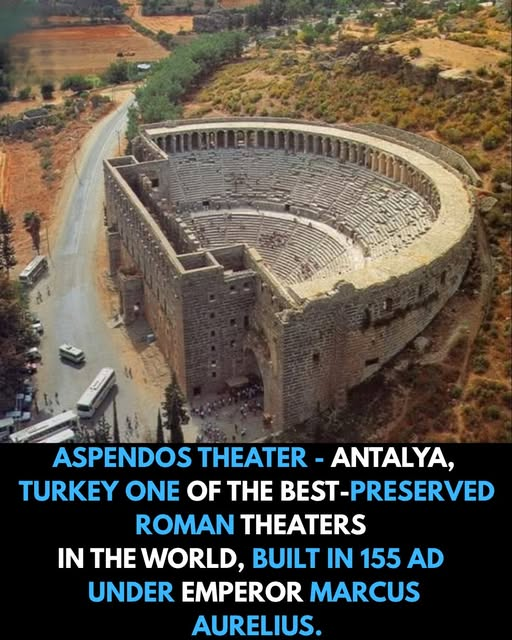
The sun rose over the dusty plains of southern Turkey, casting long shadows across olive groves and citrus trees, and lighting the ancient stones of a structure that had stood for nearly two thousand years. Towering like a great half-moon carved into the earth, the Aspendos Theater loomed quietly over the landscape—a guardian of forgotten applause, lost verses, and voices that once stirred the souls of thousands.
Here, in the heart of Antalya’s ancient past, time has not eroded history.
It has amplified it.
Aspendos was once a thriving Greco-Roman city, nestled near the banks of the Eurymedon River, a vital trade artery in the ancient world. Its wealth came from commerce, agriculture, and its strategic location near the Mediterranean coast. But its true legacy—its immortal monument—is the theater that still crowns its cultural soul.
Built in 155 AD under the reign of Emperor Marcus Aurelius, Aspendos Theater is not merely a ruin. It is a masterpiece of Roman engineering, a testament to balance, symmetry, and sound. And unlike most relics of the past, it is not silent.
It still sings.
The man behind its design was a local architect named Zenon, son of Theodorus. History records little of his life, but what he left behind speaks volumes. With mathematical precision and aesthetic grace, Zenon created a space capable of seating over 12,000 spectators—a sweeping semi-circle of stone benches that rise like waves frozen mid-motion.
But it was not size that made Aspendos remarkable.
It was sound.
The acoustics were so perfect, it’s said that a coin dropped at the center of the stage could be heard at the topmost row. Actors could speak in natural tones and reach every ear in the house, no matter the wind or the crowd. The theater’s design, with its finely calculated angles and parabolic walls, was not just architectural brilliance—it was science long before the word existed.
Imagine it.
The year is 160 AD. The city is buzzing. Merchants unload silk and spices. Fishermen haul in silver-scaled mullet from the river. Horns echo in the distance as a caravan arrives. But at the theater, all is focused. The people gather—draped in linen and leather, heads shaded with wide-brimmed hats or veils. Rich and poor alike. Citizens, travelers, children.
They climb the stone stairs.
They take their places, row upon row.
Then, silence.
A lone figure steps onto the stage, bathed in sunlight. He raises his arms. The tale begins.
Whether it was a Greek tragedy, a Roman comedy, or a philosophical debate, the Aspendos Theater was the heart of public life. Words flowed like water here—stories of gods and men, of war and peace, of love and revenge. And the stones remembered every syllable.
Even as empires crumbled and religions shifted, the theater endured.
When Rome fell and Byzantium rose, Aspendos changed, but the stage remained. In later centuries, the Seljuks admired the theater’s resilience and converted parts of it into a caravanserai. They restored sections, preserved others. Unlike so many ruins abandoned to lichen and erosion, Aspendos was used, repaired, and loved.
It never became a grave.
It remained a home—for performance, for culture, for memory.
Archaeologists who walk its corridors today speak of a strange sensation—one of walking not just through stone, but through silence charged with potential. The seats, worn smooth by centuries of use, seem to wait. The stage, though cracked and weathered, seems to yearn.
And every whisper bounces, perfectly, from one end to the other.
In their excavations, they found not only coins and pottery, but traces of a sophisticated water supply system, evidence of painted backdrops, and etchings made by ancient spectators—names, jokes, even love notes scratched into marble. It was not just a building. It was a living record of human emotion.
Today, the theater still performs.
Each summer, under the same sun that once warmed Roman brows, the Aspendos International Opera and Ballet Festival brings life back to the ancient stones. Lights illuminate the arches. Music, modern and classical, rises once more. And as the audience sits beneath a starlit Anatolian sky, one cannot help but feel that the past is not behind them.
It is beneath them.
Supporting them.
Echoing up through the seats.
And perhaps that is Aspendos’ greatest lesson—not that the Romans built grand monuments, but that they built them to last, not merely in structure, but in purpose. This was not a place of conquest. It was a place of communion. Where stories made strangers into neighbors. Where voices bridged generations. Where art became eternal.
In a world that often forgets to listen, Aspendos reminds us: some echoes are worth preserving.
If you walk there now, on a quiet afternoon when the tourists have gone, the air hums with warmth. Wind dances through the arched windows at the top of the scenae frons. Birds nest in the old stonework. And down below, you can sit in one of the seats—just one among twelve thousand—and close your eyes.
Listen.
You might hear laughter.
You might hear applause.
You might hear your own heartbeat, falling into rhythm with an empire long gone, yet somehow still breathing through this perfect circle of stone.
And when you stand to leave, it won’t feel like you’ve visited a ruin.
It will feel like you’ve been part of a performance—
One that began two millennia ago,
And still hasn’t ended.


